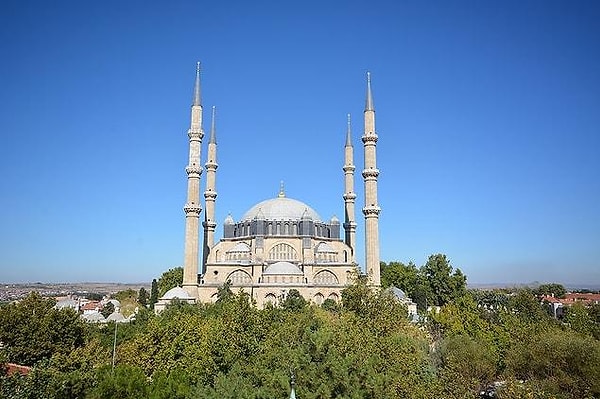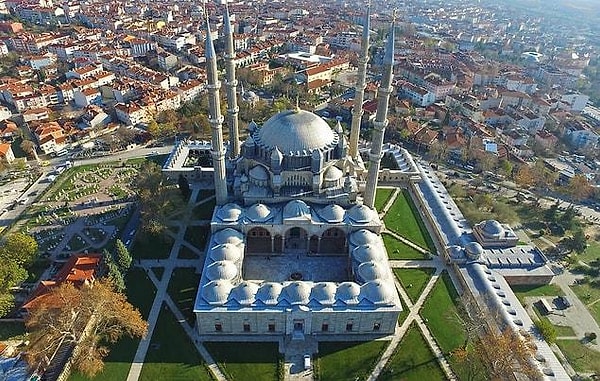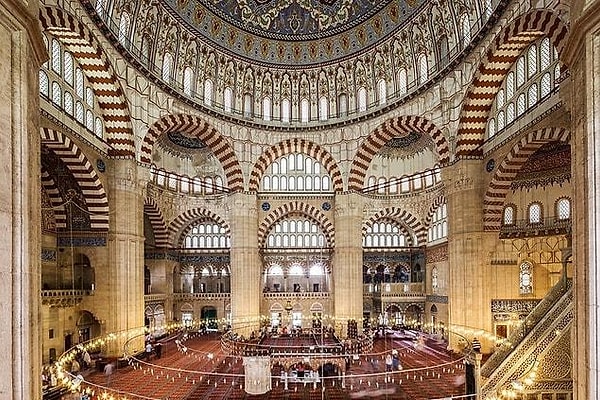The Magnificent Selimiye Mosque: Its Features, History, and Significance
Selimiye Mosque was built during the reign of the Ottoman sultan Selim II. It is considered one of the works that best reflects Ottoman architecture. The construction of Selimiye Mosque started in 1568 and the mosque was opened for worship in 1574. The Selimiye Mosque was included in the UNESCO World Heritage List in 2000 and registered as a World Heritage Site in 2011. The story of Selimiye Mosque is also very effective in gaining such a famous reputation. So where is Selimiye Mosque, by whom was it built? What are the features and story of Selimiye Mosque? Let's take a look together!
Where is Selimiye Mosque?

Selimiye Mosque is located in Edirne, Turkey. The mosque, built right in the center of the city, is in a position that can be seen from every corner of the city. It is not known exactly why Edirne was preferred for the mosque built during the Ottoman period.
Edirne was declared the capital of the Ottoman Empire when it joined the Ottoman Empire in 1362 and remained the capital until the conquest of Istanbul (1453). The construction of the Selimiye Mosque started in 1568. So, when this mosque was built in Edirne, Edirne was not the capital. There are different opinions as to why such a large mosque was built in Edirne. These are:
At that time, there was no need for a large mosque in Istanbul.
Edirne was in a central position in terms of Ottoman sovereignty in Rumelia.
Selim, the sultan of the period, had been left in Edirne in his youth by Kanuni to protect the throne, and Selim had a special affection for Edirne that started in his youth.
Who is the Architect of Selimiye Mosque?

The architect of the Selimiye Mosque is Mimar Sinan. Mimar Sinan started the construction of the mosque when he was 90 years old. Mimar Sinan describes the Selimiye Mosque as his 'Masterpiece'. Mimar Sinan completed his apprenticeship work 'Şehzade Mosque' in 1548 and his master's work 'Süleymaniye Mosque' in 1557.
Selimiye Mosque is so big and so centrally located that it can be easily seen from everywhere in Edirne. It is known that a technique that has never been used in any building before was used in the construction of the Mosque built by Sultan Selim. It is possible to see Mimar Sinan's mathematical intelligence in the dome and minarets of the mosque. The dome built by Mimar Sinan is bigger and more durable than the dome of Hagia Sophia.
What are the Features of Selimiye Mosque?

Selimiye Mosque is of great importance for Ottoman culture with its architectural features that impress people from every period. Selimiye Mosque continues to preserve its splendor with both its historical features and architectural techniques and continues to challenge the years. Selimiye Mosque continues to attract attention with its story as well as the construction techniques used.
Selimiye Mosque is considered to be one of the works that best reflects the architectural understanding of the Ottoman period. Especially the dome and minarets of the mosque add a great splendor to the mosque. The dome, which looks quite imposing from the outside, reveals how big and high the mosque is when you enter inside.
The height of the dome is 42.30 meters and its diameter is 31.30 meters. It is known that the weight of the dome is 2000 tons. The dome was built as a single dome with a single lebi, that is, instead of gradually rising domes. In order to carry such a large dome, a pulley system based on a total of 8 columns was established. The pulley is connected to the filial (the thick column used to carry the domes) by arches 6 meters wide.
The Selimiye Mosque, which is large enough for about 6 thousand people to pray at the same time, is illuminated by large windows in the dome pulley and hundreds of small windows in the wall. The windows are positioned in such a way that such a large mosque is perfectly illuminated.
Thanks to the mosque's large dome and lighting system, the interior of the mosque is very spacious and bright. With all these features, Selimiye Mosque continues to be recognized as an architectural wonder and attracts the attention of architects from all over the world.
One of the most remarkable features of Selimiye Mosque is its minarets. The minarets are designed in the slimmest and tallest way possible.

The length of the minarets at the four corners of the mosque is 70.89 meters. The height of the minarets including the realm is given as 84 meters in some sources and 85 meters in others. The diameter of the minarets is 380 centimeters. The minarets are designed quite thin and tall.
One of the most interesting features of the minarets is that they have three separate staircases leading to three different levels. This means that the stairs to the various levels of the minaret, located at different heights, are not the same. Within a minaret, there are three different spiral staircases. Only the two minarets next to the mosque's main entrance have this feature, while the other minarets have only one staircase. The minarets' proximity to the dome gives the impression that the mosque is reaching towards the sky (towards Allah). The construction of tall places of worship is also present in Gothic architecture. The height of these tall places of worship is thought to symbolize their majesty and power.
One detail in particular attracts attention in the interior decorations of the Selimiye Mosque: the inverted tulip motif.

One of the most well-known motifs of the Selimiye Mosque is the inverted tulip motif. According to legend, the inverted tulip motif is a kind of 'reference' by Mimar Sinan. It is not known what the truth is, but it is said that there was a tulip garden where the Selimiye Mosque was to be built. The owner of this tulip garden is a difficult man and refused to give up his garden.
Mimar Sinan managed to buy the land after long efforts. The owner of the garden makes a request: he demands that the tulip motif be included in the mosque. Mimar Sinan carves a tulip motif on one of the marble legs of the muezzin mahfil of the mosque. The reason why this motif is upside down is known as the difficulties caused by the owner.
According to another rumor, the reason Mimar Sinan carved an inverted tulip motif was that he had lost his grandchild during the construction of the mosque. Mimar Sinan carved an inverted tulip motif to honor the memory of his grandchild. However, it should be noted that these are only rumors. We cannot be sure whether they reflect the facts or not.
The interior and exterior of the mosque are decorated with many different motifs. Especially marble, tiles and calligraphy were used in the mosque. The tiles were produced in Iznik, the most important tile production center of the period. It is known that there are 101 different tulip patterns in the decorations of the mosque. In addition, wood and mother-of-pearl embroideries give the mosque a very aesthetic appearance. The fountain in the garden of the mosque is completely made of marble.
Another remarkable feature of the Selimiye Mosque is the path followed by the soot of the torches used for lighting. The lit torches follow such a path with the air flow that they go out through a special hole without leaving any trace in the mosque. Mimar Sinan also created a soot room in the Süleymaniye Mosque, which he described as his master's work.
History and Importance of Selimiye Mosque

It is estimated that about 15 thousand people worked on the construction of the Selimiye Mosque. The construction of the mosque took 7 years. It took 2 years for the ground of the mosque to become solid. Mimar Sinan was thus able to create works that read for centuries. Selimiye Mosque was built during the reign of Selim II, but Sultan Selim died before he could see the opening of the mosque. The mosque was developed by Yıldırım Bayezid and used for many purposes in its time.
Mimar Sinan described the Selimiye Mosque as his 'masterpiece'. Selimiye Mosque was included in the World Heritage List by UNESCO in 2000 and registered as a World Heritage Site in 2011.
Keşfet ile ziyaret ettiğin tüm kategorileri tek akışta gör!


Send Comment